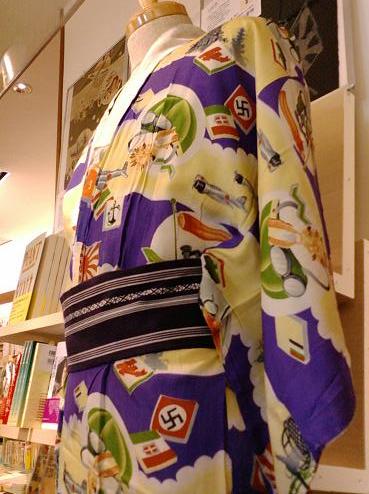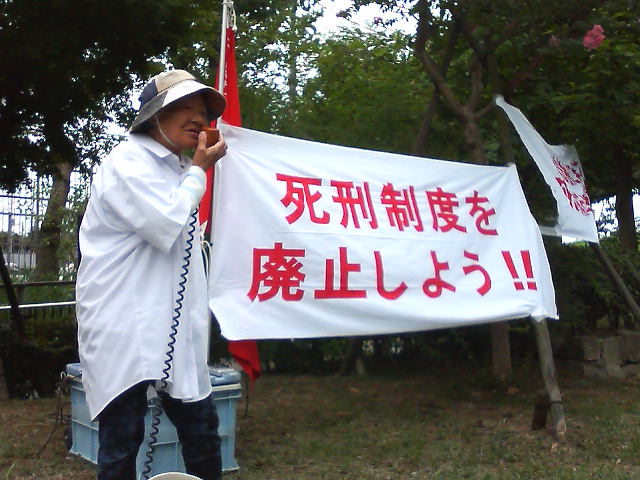I could have sworn that the “Westerner’s Fear of Neonsigns” blog was written by Marxy on a gaijin-baiting stint, but apparently that’s not the case. Whoever writes it, however, is amazing and I especially love his post “How’s your Japan blog?”
1. Japan is unintentionally hilarious – in particular, misuse of English – or Engrish – is so funny that I devote considerable time to documenting and disseminating it. To avoid a similar fate, I will not be blogging in Japanese.
2. Japan is barbaric – it fails to treat sacred Western food with due decorum (bread in a can) and celebrates Christian festivals all wrong (Kentucky Fried Chicken on Christmas Eve). Check my blog for further examples.
3. Japan is sexually deviant – society operates in the tacit knowledge that Japanese men are paedophiles by default. Look at all the photographic evidence I have amassed to prove it. They just don’t know how to treat a woman properly. That I do is the underlying message I want you to receive from my blog.
4. Japan is a visual paradise (1) – all Japanese have a heightened visual sensibility; they spend their coffee breaks contemplating tiny design modifications to plastic cups and bathe in the juice of fonts come evening. Not actually living in Japan, I can safely say that they never drive ugly white minivans or fill their tatami rooms with tat.
5. Japan is a visual paradise (2) – the thing I love about Japan is how it allows me to me indulge in the objectification of women without guilt or reproach. The pornography here is just fantastic. Oh, of course, this will be known as The Great Unmentioned in my blog.
6. Japan is spineless and work-addicted – people will do any job rather than lose esteem by not working. Look at this old man waving past cars with a pair of red wands – you wouldn’t catch me stooping to do such a demeaning and unnecessary job. Oh, excuse me, I’m late for my English conversation school class.
7. Japan is childish – public announcements are only heeded when they are delivered by curtseying cartoon characters. To prove it, I will photograph them all. Even though the large incidence of such messages is obvious, I will continue to treat each one as a fantastic novelty.
8. I am childish – only in Japan can I indulge my secret love of toys and games while presenting it as sociological research. I never miss an opportunity to make the sweeping observation that Japan is populated by inadequate geeks. I visit Akihabara every weekend in search of corroborating evidence, but it’s purely research you understand.
9. Japan loves me – it’s always saying how tall I am, how handsome I am, how intelligent I am (admit it, I am pretty hot at producing those L/R sounds), how good I am at sports, how amazing it is that I am a man and yet I cook for myself. Nobody said anything in my home country except: “So, are you finally going to get laid in Japan?” Deeper awareness of Japanese social etiquette would have saved me the trouble of believing any of this.
10. Japan is mine – I am the Alpha Gaijin. If Japan can be said to exist at all, it is only because I have brought it to life with my intellectual efforts. Other foreigners intruding on my turf better be able to withstand the fire of my comments. Japan will thank me for everything I have accomplished once it knows who I am. Until then, I have an immersion experience more impressive than yours to attend to.
I feel like I was the opposite of other Japan bloggers, at least by this person’s definition – I was more into blogging about Japan when I wasn’t here. Now that I live here it is all so uninspiring.
This analysis of Japan blogs is as spot-on as it has been curiously absent in unfiltered form. Still, in defense of Japan blogs I will say that it is often a lot of fun to post and discuss the interesting and weird stuff in a foreign land, whether that’s Japan or elsewhere. It is definitely shrill-sounding when people make their experiences out to be more than they are (god, there are thousands of expats just in Asia, you’re not that special), but really the antidote to Japan blog fatigue is to just tune them out.
The truth is I am sad we weren’t even mentioned (though in a separate post he calls translation one of the “brilliant arts” so maybe I don’t get called on my own cultural imperialism. Or maybe I just didn’t get noticed by not posting when the blog launched…)
Speaking of cautionary tales and immersion experiences, I took no less than 4 friends on a wild goose chase the other day to see what was supposedly an exhibit of Nazified kimonos celebrating the tripartite alliance in the WW2 era. This is all we found next to a display of books on wartime Japan:

Meanwhile, today’s Asahi (I read the print edition now, screw the crap online version!) ran a feature on a sweet sounding historical fiction “Tokyo Year Zero” about a double murder in early postwar Japan. The author, David Peace, grew interested in postwar Japan after teaching English here in the early 90s and reading Seidenstecker’s Tokyo Rising. He later returned to his native England and became an award-winning mystery writer on non-Japan related subject matter. His new book is enjoying a simultaneous bilingual release and a major PR push from the Japanese publisher Bungei Shunju.
Just goes to show, if you’re willing to shed a little baggage and be friendly to the like-minded (most of the research for his new book was apparently provided by the in-house Bungei Shunju translator after the two hit it off during negotiations for translation rights to an earlier Peace book), you too can have success and avoid the stench of “slow-burning underachievement” that apparently afflicts the expat population in Japan.


![日比谷公園音楽堂[拡大画像]を開く](http://www.ndl.go.jp/scenery/images/M/40007751/00000/0006_2.jpg)
